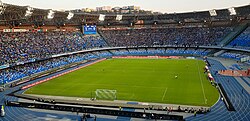Stadio Diego Armando Maradona
 | |
 | |
| Former names | Stadio del Sole (1959–63) Stadio San Paolo (1963–2020) |
|---|---|
| Location | Naples, Campania, Italy |
| Coordinates | 40°49′41″N 14°11′35″E / 40.8280°N 14.1930°E |
| Owner | Comune di Napoli |
| Executive suites | 20 |
| Capacity | 54,726 (all-seater) |
| Record attendance | 90,736 (Napoli v Juventus, 15 December 1974) |
| Field size | 110 m × 68 m (361 ft × 223 ft) |
| Surface | Grass |
| Construction | |
| Broke ground | 1952 |
| Built | 1952–1959 |
| Opened | 6 December 1959 |
| Renovated | 1989–1990, 2018–2019 |
| Architect | Carlo Cocchia, Luigi Corradi |
| Tenants | |
| SSC Napoli (1959–present) Italy national football team (selected matches) | |
Stadio Diego Armando Maradona, formerly known as Stadio San Paolo,[1][2] is a stadium in the western Fuorigrotta suburb of Naples, Italy. It is the fourth largest football stadium in Italy,[3] after Milan's San Siro, Rome's Stadio Olimpico and Bari's San Nicola. Completed in 1959, the stadium currently accommodates 54,726, but in the past with terraced sections that number could reach approximately 90,000 spectators.[4] It is the home of SSC Napoli, the reigning Serie A champions.
History
[edit]This section needs expansion with: Early history. You can help by adding to it. (December 2020) |
Naples was in need of a replacement for the Stadio Partenopeo, which had been destroyed during the bombing of Naples in the Second World War. The district of Fuorigrotta, which was rapidly expanding, was chosen as the site for the new stadium. Construction began in 1952 on an open-air, reinforced concrete stadium that was able to hold about 90,000 mostly standing fans. The laying of the first cornerstone was attended by then-Prime Minister, Alcide De Gasperi. It took seven years to complete, with the first match played there being a 2–1 Napoli win over rivals Juventus on 6 December 1959.[5][6]
The stadium was renovated extensively for the 1990 World Cup, which involved the removal of its standing areas as it was converted to an all-seater venue.
Even though Napoli was in the Serie C1 during the 2005–06 season, Napoli achieved the feat of having the 3rd highest average home attendance in Italy for the season, with only two Serie A clubs, AC Milan and Inter Milan recording higher attendances. Napoli's final game of the season drew a crowd of 51,000 which now stands as a Serie C all-time record.

The stadium was renovated from 2018–2019 in preparation for the XXX Summer Universiade; this included replacing metal fencing with glass barriers and replacing seats. This meant the stadium's capacity was reduced from 60,240 to 54,726.[7]
Following the death of club legend Diego Maradona in November 2020, city mayor Luigi de Magistris and Napoli president Aurelio De Laurentiis proposed renaming the stadium to "Stadio Diego Armando Maradona." The proposal was passed on 4 December 2020, and was announced by the mayor on social media and made official that same day.[2]
Notable Events
[edit]The stadium hosted five matches during the 1990 FIFA World Cup, one of which being a contest between Argentina and Italy on 3 July 1990. The atmosphere was emotionally charged, as Diego Maradona, the superstar of Argentina's national team, also played for Napoli. He was an icon to Naples for bringing the club their first two Serie A titles. The Neapolitan tifosi responded by hanging a giant flag in their "curva" of the stadium saying "Maradona, Naples loves you, but Italy is our homeland".[8] Maradona later said he was touched that it was the only stadium during the World Cup where the Argentinian national anthem was not jeered. The match finished 1–1 after extra time. A penalty shoot-out ensued, with Argentina winning and Maradona scoring one of their penalties.
The XXX Summer Universiade, the 30th installment of the FISU World University Games, took place between 3 and 14 July 2019. The opening ceremony featured an appearance by President Sergio Mattarella, Olympic gold-medalist Massimiliano Rosolino, and a performance by renowned Italian artist Andrea Bocelli.
Other Events
[edit]For the 1960 Summer Olympics in Rome, the stadium hosted the football preliminaries.
The stadium hosted Italy's Euro 2008 qualifier against Lithuania on 2 September 2006.
References
[edit]- ^ Edwards, Andy (4 December 2020). "Napoli's stadium now officially Stadio Diego Armando Maradona". NBC Sports.
Originally named the Stadio San Paolo, after Saint Paul the Apostle, Napoli's home stadium will henceforth be called the Stadio Diego Armando Maradona.
- ^ a b "Official: Stadio Diego Armando Maradona". Football Italia. 4 December 2020.
- ^ "Stadio San Paolo". The Stadium Guide. 23 March 2015. Retrieved 29 October 2021.
- ^ "Stadio Diego Armando Maradona (Stadio San Paolo) –". Stadiumdb.com. Retrieved 2022-08-22.
- ^ "San Paolo Stadium Naples: History and Facts". We Build Value. 2021-04-29. Retrieved 2025-06-04.
- ^ "SSC Napoli - Juventus 2:1 (Serie A 1959/1960, 10. Round)". worldfootball.net. Retrieved 2025-06-04.
- ^ "Naples: The great... no, it's just repairs for San Paolo – StadiumDB.com". stadiumdb.com.
- ^ Maradona, Diego (2004). El Diego, pg. 166.


